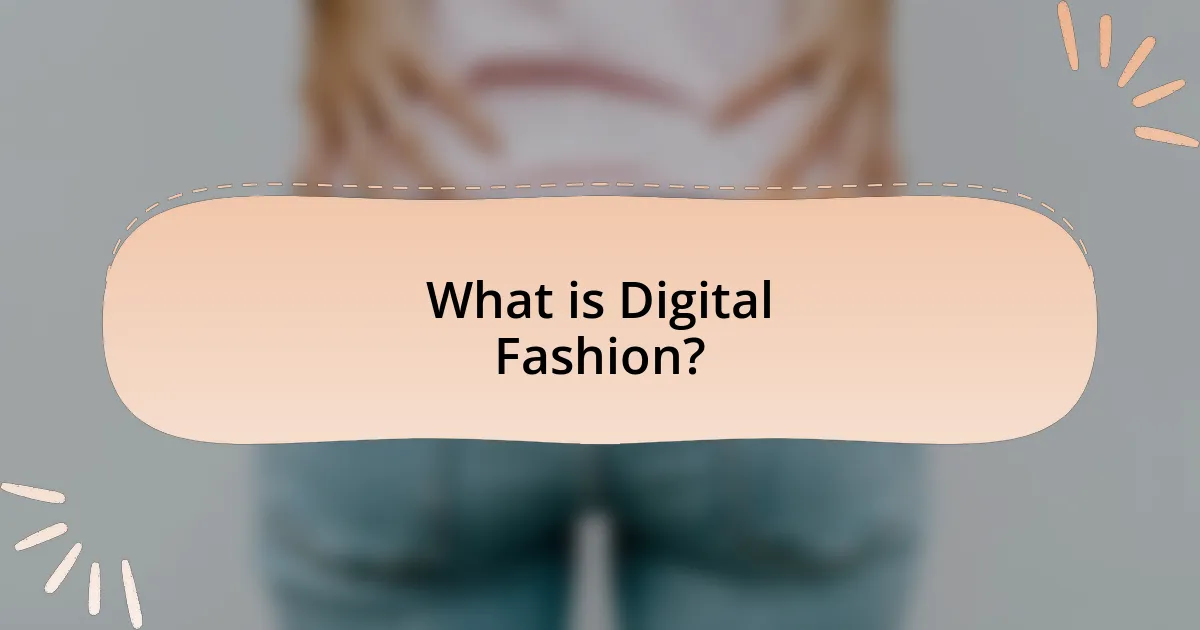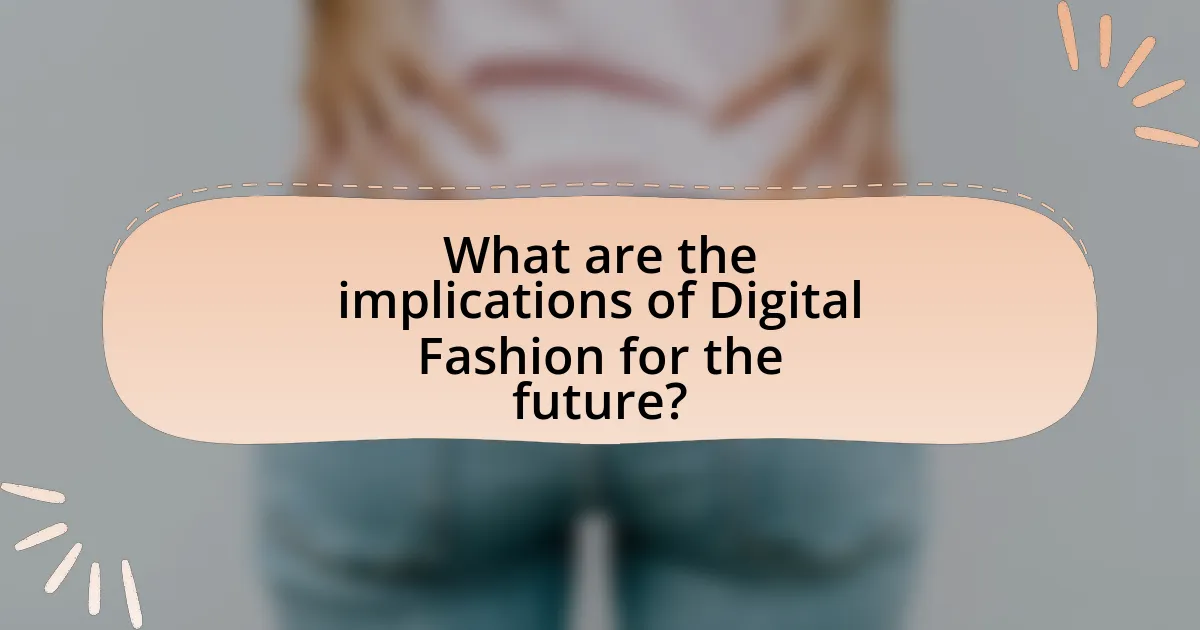Digital fashion is defined as clothing and accessories that exist in virtual environments, created through digital design software and 3D modeling techniques. This article explores the rise of digital fashion, highlighting its key characteristics, differences from traditional fashion, and the cultural and technological shifts driving its popularity. It examines current trends in virtual clothing, the integration of digital garments by major brands, and consumer responses to virtual collections. Additionally, the implications of digital fashion for sustainability and future developments in the industry are discussed, emphasizing the role of social media and influencers in shaping perceptions and trends within this evolving landscape.

What is Digital Fashion?
Digital fashion refers to clothing and accessories that exist in a virtual environment, primarily created using digital design software and 3D modeling techniques. This innovative approach allows designers to create garments that can be worn in virtual spaces, such as video games, social media platforms, and augmented reality applications. The rise of digital fashion is supported by the increasing popularity of virtual worlds and the demand for unique, customizable digital identities, with brands like Balenciaga and Gucci launching virtual collections that cater to this trend.
How is Digital Fashion defined in today’s context?
Digital fashion is defined as the creation and use of virtual clothing and accessories that exist in digital environments, such as video games, social media, and virtual reality platforms. This contemporary form of fashion allows users to express their identity and style in digital spaces without the constraints of physical materials. The rise of digital fashion is supported by advancements in technology, including 3D modeling and augmented reality, which enable realistic representations of clothing. According to a report by McKinsey & Company, the digital fashion market is projected to grow significantly, reflecting a shift in consumer behavior towards virtual experiences and sustainability in fashion.
What are the key characteristics of Digital Fashion?
Digital fashion is characterized by its virtual nature, allowing for the creation and manipulation of clothing in digital environments. This form of fashion leverages advanced technologies such as 3D modeling, augmented reality, and virtual reality to design garments that exist solely in digital spaces. Additionally, digital fashion promotes sustainability by reducing waste associated with traditional clothing production, as it eliminates the need for physical materials. The rise of social media and online platforms has also enabled digital fashion to thrive, allowing designers to showcase their work to a global audience without the constraints of physical fashion shows. Furthermore, digital fashion often incorporates interactive elements, enabling users to engage with clothing in innovative ways, such as through virtual try-ons or customizable avatars.
How does Digital Fashion differ from traditional fashion?
Digital fashion differs from traditional fashion primarily in its medium and application; digital fashion exists in virtual environments and is created using computer-generated imagery, while traditional fashion involves physical garments made from textiles. Digital fashion allows for limitless creativity, enabling designers to experiment with styles and materials that may not be feasible in the physical world, such as animated textures or interactive elements. Additionally, digital fashion can be worn in virtual spaces, such as video games or social media platforms, allowing for a broader reach and engagement without the constraints of physical production, which often involves significant resources and environmental impact. This shift is supported by the growing popularity of virtual reality and augmented reality technologies, which facilitate immersive experiences and interactions with digital clothing.
Why is Digital Fashion gaining popularity?
Digital fashion is gaining popularity due to its ability to merge technology with creativity, allowing for innovative designs that are not constrained by physical limitations. The rise of virtual environments, such as gaming and social media platforms, has created a demand for digital clothing that enhances online identities and self-expression. According to a report by McKinsey & Company, the global digital fashion market is projected to grow significantly, driven by consumer interest in sustainability and the desire for unique, customizable fashion experiences. This trend is further supported by collaborations between fashion brands and digital artists, which have resulted in high-profile virtual fashion shows and collections, showcasing the potential of digital garments in mainstream fashion.
What cultural shifts are influencing the rise of Digital Fashion?
The rise of Digital Fashion is primarily influenced by the cultural shifts towards sustainability, virtual identity expression, and the increasing integration of technology in daily life. Sustainability concerns drive consumers to seek eco-friendly alternatives, leading to digital clothing that reduces waste associated with traditional fashion production. Additionally, the growing acceptance of virtual identities, especially in online gaming and social media, encourages individuals to express themselves through digital garments. Furthermore, advancements in technology, such as augmented reality and blockchain, facilitate the creation and ownership of digital fashion items, making them more accessible and appealing to a tech-savvy audience. These cultural shifts collectively contribute to the burgeoning interest and investment in Digital Fashion.
How do technological advancements contribute to the growth of Digital Fashion?
Technological advancements significantly contribute to the growth of Digital Fashion by enabling the creation, distribution, and consumption of virtual clothing. Innovations such as 3D modeling software, augmented reality (AR), and virtual reality (VR) allow designers to create realistic digital garments that can be worn in virtual environments. For instance, platforms like Clo3D and Marvelous Designer facilitate the design process, allowing for intricate details and realistic fabric simulations. Additionally, the rise of blockchain technology enhances the authenticity and ownership of digital fashion items through non-fungible tokens (NFTs), which have seen a market growth of over $10 billion in 2021 alone. These advancements not only streamline the design process but also expand the market reach, allowing consumers to engage with fashion in immersive ways, thus driving the overall growth of Digital Fashion.

What are the current trends in Virtual Clothing?
Current trends in virtual clothing include the rise of digital fashion shows, increased collaboration between fashion brands and gaming platforms, and the growing popularity of virtual try-on technology. Digital fashion shows, such as those hosted by Balenciaga and Gucci, leverage virtual environments to showcase collections, reaching wider audiences without physical limitations. Collaborations with gaming platforms like Fortnite and Roblox allow brands to create exclusive virtual outfits, enhancing brand engagement among younger consumers. Additionally, virtual try-on technology, powered by augmented reality, enables consumers to visualize clothing on themselves before purchase, improving the online shopping experience. These trends reflect a shift towards immersive and interactive fashion experiences in the digital realm.
How are brands integrating Virtual Clothing into their offerings?
Brands are integrating virtual clothing into their offerings by creating digital garments for use in virtual environments, such as social media platforms and video games. For instance, companies like Balenciaga and Gucci have launched virtual collections that allow users to dress their avatars in high-fashion items, enhancing brand engagement and expanding their market reach. Additionally, platforms like Roblox and Fortnite have collaborated with fashion brands to offer exclusive virtual clothing items, demonstrating a growing trend in the intersection of fashion and digital experiences. This integration not only caters to the increasing demand for digital identity expression but also taps into the lucrative market of virtual goods, which is projected to reach billions in revenue as consumer interest in digital fashion continues to rise.
What are some notable examples of brands successfully using Virtual Clothing?
Notable examples of brands successfully using virtual clothing include Balenciaga, Gucci, and Nike. Balenciaga launched a digital collection in collaboration with Fortnite, allowing players to purchase and wear virtual outfits in the game, which generated significant buzz and engagement. Gucci created a virtual sneaker line that can be worn in digital environments, showcasing their innovative approach to blending fashion with technology. Nike introduced the “Nikeland” experience on Roblox, where users can dress their avatars in Nike gear, further integrating virtual clothing into gaming and social platforms. These brands demonstrate the effectiveness of virtual clothing in enhancing brand visibility and consumer interaction in the digital space.
How do consumers respond to Virtual Clothing collections?
Consumers generally respond positively to virtual clothing collections, showing increased interest and engagement with digital fashion. This response is driven by factors such as the novelty of virtual try-ons, the ability to express individuality without physical constraints, and the growing acceptance of digital identities in social media and gaming environments. Research indicates that 67% of consumers are open to purchasing virtual clothing, particularly in the context of online gaming and social media platforms, where digital fashion allows for unique self-expression and creativity. Additionally, brands that offer virtual clothing collections often see enhanced brand loyalty and consumer interaction, as these collections align with the values of sustainability and innovation that resonate with modern consumers.
What role do social media and influencers play in Virtual Clothing trends?
Social media and influencers significantly shape virtual clothing trends by driving visibility and consumer engagement. Platforms like Instagram and TikTok allow influencers to showcase virtual outfits, creating a direct connection between digital fashion brands and potential customers. For instance, a study by the Fashion Institute of Technology found that 70% of consumers are influenced by social media when making fashion purchases, highlighting the power of these platforms in promoting virtual clothing. Influencers often collaborate with digital fashion brands, leading to increased brand awareness and consumer interest, which ultimately propels the growth of virtual clothing trends in the digital marketplace.
How do influencers impact the perception of Digital Fashion?
Influencers significantly shape the perception of digital fashion by leveraging their reach and credibility to promote virtual clothing and brands. Their endorsements often lead to increased visibility and acceptance of digital fashion among consumers, as influencers showcase these items in engaging and relatable contexts. For instance, a study by the University of Southern California found that 70% of consumers are more likely to purchase a product after seeing it endorsed by an influencer. This demonstrates that influencers not only drive trends but also enhance the legitimacy of digital fashion, making it more appealing to a broader audience.
What platforms are most effective for promoting Virtual Clothing?
Social media platforms, particularly Instagram, TikTok, and Snapchat, are the most effective for promoting virtual clothing. These platforms have a visually-driven user base that engages with fashion content, making them ideal for showcasing digital garments. For instance, Instagram’s shopping features allow brands to tag products directly in posts, facilitating seamless purchases. TikTok’s algorithm promotes viral content, enabling virtual clothing brands to reach a wider audience quickly. Additionally, Snapchat’s augmented reality (AR) capabilities allow users to try on virtual clothing, enhancing user interaction and engagement. These features collectively support the promotion of virtual clothing effectively.

What are the implications of Digital Fashion for the future?
Digital fashion will significantly reshape the future of the fashion industry by introducing sustainable practices, enhancing consumer engagement, and creating new economic models. The shift towards digital clothing reduces the environmental impact associated with traditional fashion production, as it eliminates the need for physical materials and manufacturing processes. For instance, a report by McKinsey & Company highlights that digital fashion can decrease waste and carbon emissions, aligning with global sustainability goals. Additionally, digital fashion fosters innovative consumer experiences through virtual try-ons and immersive environments, as seen in platforms like Roblox and Fortnite, which engage users in unique ways. This evolution also opens avenues for new revenue streams, such as virtual fashion shows and digital wearables, which are projected to grow in popularity and profitability. Overall, the implications of digital fashion encompass sustainability, enhanced consumer interaction, and economic innovation, marking a transformative shift in the industry.
How might Digital Fashion evolve in the coming years?
Digital fashion is likely to evolve significantly in the coming years through advancements in technology, increased consumer acceptance, and the integration of augmented reality (AR) and virtual reality (VR). As technology progresses, digital fashion will become more immersive, allowing users to experience virtual clothing in real-time environments, enhancing the shopping experience. For instance, the global AR and VR market is projected to grow from $30.7 billion in 2021 to $300 billion by 2024, indicating a strong trend towards immersive digital experiences. Additionally, as sustainability becomes a priority, digital fashion offers a more eco-friendly alternative to traditional clothing production, reducing waste and resource consumption. This shift is supported by a growing number of brands, such as Balenciaga and Gucci, investing in digital collections, which reflects a broader acceptance of virtual fashion among consumers.
What technological innovations could shape the future of Digital Fashion?
Technological innovations such as augmented reality (AR), virtual reality (VR), blockchain, and artificial intelligence (AI) are poised to significantly shape the future of digital fashion. AR and VR enable immersive experiences for consumers, allowing them to try on virtual clothing in real-time, enhancing online shopping experiences. Blockchain technology provides transparency and authenticity in digital fashion, ensuring ownership and provenance of virtual garments, which is crucial for digital asset management. AI contributes by personalizing fashion recommendations and optimizing design processes, making it easier for brands to create tailored collections. These innovations collectively enhance user engagement, streamline production, and foster a more sustainable fashion ecosystem.
How will sustainability concerns influence Digital Fashion trends?
Sustainability concerns will significantly influence Digital Fashion trends by driving the demand for eco-friendly virtual clothing solutions. As consumers become increasingly aware of the environmental impact of traditional fashion, brands are responding by creating digital garments that reduce waste and resource consumption. For instance, a report from McKinsey & Company highlights that the fashion industry is responsible for 10% of global carbon emissions, prompting a shift towards digital alternatives that minimize physical production. This trend is further supported by the rise of platforms like DressX, which allows users to purchase and wear digital outfits, thereby promoting sustainable practices in the fashion industry.
What are best practices for engaging with Digital Fashion?
Best practices for engaging with Digital Fashion include leveraging social media platforms, collaborating with influencers, and utilizing immersive technologies like augmented reality (AR). Engaging on social media allows brands to reach a wider audience and foster community interaction, as evidenced by the significant increase in user engagement rates on platforms like Instagram and TikTok, where fashion content thrives. Collaborating with influencers can enhance brand visibility and credibility; for instance, a study by Influencer Marketing Hub found that 63% of consumers trust influencers’ opinions more than brand advertisements. Utilizing AR technology enables consumers to visualize clothing in a virtual environment, enhancing the shopping experience and reducing return rates, as reported by a survey from Shopify, which indicated that 40% of consumers prefer to shop with AR features.
How can consumers effectively participate in the Digital Fashion space?
Consumers can effectively participate in the Digital Fashion space by engaging with virtual clothing platforms and utilizing digital avatars. These platforms, such as Decentraland and The Sandbox, allow users to purchase, wear, and showcase digital garments, thus creating a personalized fashion experience. According to a report by McKinsey & Company, the digital fashion market is projected to grow significantly, indicating a rising trend in consumer interest and participation. By actively exploring these platforms, consumers can influence trends and contribute to the evolving landscape of digital fashion.
What tips can brands follow to succeed in the Digital Fashion market?
Brands can succeed in the Digital Fashion market by focusing on creating immersive experiences, leveraging social media for engagement, and ensuring sustainability in their offerings. Immersive experiences, such as virtual try-ons and augmented reality features, enhance customer interaction and satisfaction, as evidenced by the success of platforms like Gucci and Balenciaga that utilize AR technology. Engaging with consumers through social media channels allows brands to build communities and foster loyalty, with studies showing that 54% of consumers prefer to interact with brands on social media. Additionally, prioritizing sustainability resonates with the growing consumer demand for eco-friendly practices, as 66% of global consumers are willing to pay more for sustainable brands, according to Nielsen.




